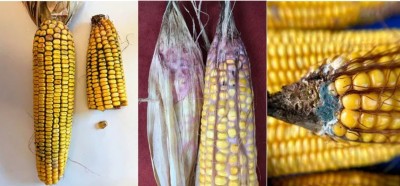What are mycotoxins?

By A. Murrio-Williams, P. Esker & A. Collins: Penn State Extension
Mycotoxins are toxic substances produced by fungi (mycotoxigenic fungi) on the different substrates where they grow. Mycotoxins can be toxic when inhaled, absorbed through the skin, or consumed at very low concentration levels, which means that even a few milligrams in food or feed may pose a risk for human and animal health.
Which crops are affected by mycotoxins?Mycotoxigenic fungi affect a wide range of plants and grain crops, including corn, peanut, wheat, barley, rye, and oat. Given that mycotoxins are heat-tolerant, they will not be affected by drying and most food and feed processing operations.
What are the effects of mycotoxins on human and animal health?A disease caused by mycotoxins is called mycotoxicosis. The effects of mycotoxicosis can either be acute, leading to severe symptom development after a short exposure to high doses, or chronic, which is the result of long-term exposure to small quantities of the toxin. The degree of susceptibility to mycotoxins in humans and animals is complex and impacted by many factors including the toxicity of the mycotoxin, age, nutrition, and interactions with certain diseases, other mycotoxins, and/or substances.
How many mycotoxins are there?To date, more than 400 mycotoxins have been described. However, most research and world-wide regulations have focused on the group of the most toxic and prevalent mycotoxins, including aflatoxins, ochratoxin A, patulin, fumonisins, zearalenone, and the group called trichothecenes: deoxynivalenol (AKA DON or vomitoxin), nivalenol, T-2, and HT-2. Aflatoxins are produced mainly by Aspergillus flavus and Aspergillus parasiticus. Fusarium species will produce fumonisins, zearalenone and trichothecenes. Ochratoxins are produced by Aspergillus and Penicillium species; and patulin is produced mainly by Penicillium. Some of these fungal species produce more than one toxin, and crops can be affected by more than one fungal species at a time. Therefore, multi-mycotoxin contamination of grain crops tends to be the norm, not the exception.
What is the effect of mycotoxigenic fungi in grain crops?In addition to mycotoxin contamination of grain crops, mycotoxigenic fungi can cause ear rots (Fusarium ear rot, Gibberella ear rot, Aspergillus ear rot) and stalk rots in corn. It is important to highlight that not all stalk rots and ear rots are caused by mycotoxigenic fungi. The list of the most common ear rots found in Pennsylvania can be found in our previous publication "Corn ear rots and Mycotoxins". In wheat and barley, Fusarium head blight will cause grain to be light-weight and shriveled. Co-contamination of grain crops with more than one fungal species is common, therefore, co-contamination with more than one mycotoxin is also common.
When do mycotoxin outbreaks occur?In the past, it was believed that mycotoxigenic fungi affected grain only during the postharvest stage, particularly when grain was stored under suboptimal conditions like high moisture content, and in a hot and humid environment. Although these factors will promote fungal growth in storage, it is well known that some of the most important mycotoxigenic fungi infect corn and small grains during the growing season and that drying and storing grain at optimal conditions will not reduce mycotoxin concentrations already present in the harvested grain. In the field, mycotoxin outbreaks are seasonal, and will occur under favorable weather conditions for disease development. Insect or bird damage can increase the risk for mycotoxin contamination.
What are favorable environmental conditions for infection by mycotoxigenic fungi?There is not a straightforward answer to this question, because it varies according to the crop and the fungi's specific requirement for infection and mycotoxin contamination. Environmental conditions have a direct effect on dispersion of fungal spores, and the ability of the fungus to penetrate and establish within the tissues of the susceptible host. For instance, high temperatures and drought favor aflatoxin contamination of maize, as do the same conditions that are conducive for insect damage. Hot and dry weather during or after silking favors Fusarium ear rot of corn, while Gibberella ear rot will thrive if those conditions are cool and moist.
Fortunately, FDA has published guidelines on permissible levels of these toxins in food and feed. In upcoming articles, we will address the effects of specific toxins on grain crops and animals.
Upcoming Events
WEBINAR - Automated Milking Systems Efficiency: Balancing Focus on Individual Cows and System Optimization
May 8, 2024
Please join Cornell the SWNY team and MSU Extension for our talk with Dr. Pablo Silva Boloña on improving efficiency of Automated milking systems by focusing on milking settings for individual and group success.
Broiler Field Day at Sunny Cove Farm
June 6, 2024
Alfred Station, NY
Join us for a field day to explore broiler production, processing, and finances. Meghan Snyder of Sunny Cove Farm will be our host. She raises small batches of organic broilers, processing them on-farm under the 1,000 bird exemption.
Stockmanship and Stewardship 2024
October 25, 2024
Hamburg, NY
Save the date!! The event is one of 4 across the US and is a two-day educational experience featuring low-stress cattle handling demonstrations, Beef Quality Assurance educational sessions, facility design sessions, and industry updates.
Announcements
No announcements at this time.





